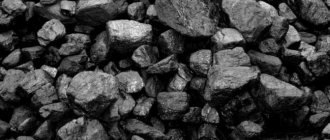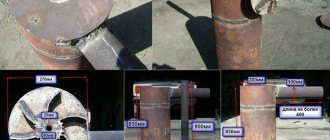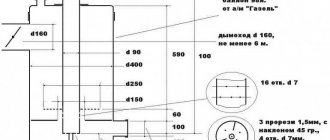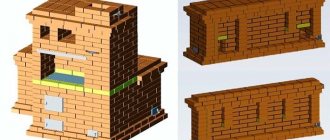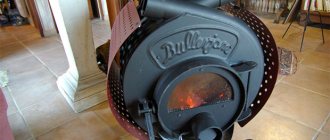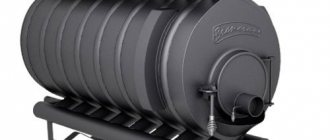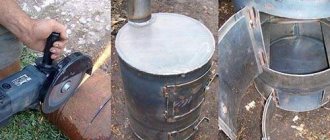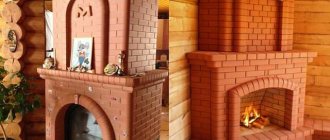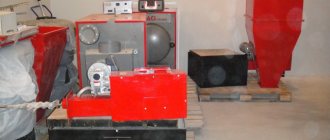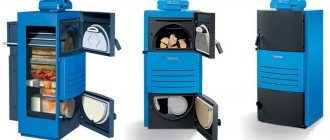Now we will not talk about high energy technologies or even household fireplaces, but about good old Russian stoves. And this is not surprising, because with the return of fashion for wooden estates, the fashion for the original Russian source of heat has returned. This is a completely autonomous structure that does not require connection to utility networks and heats the house with heat accumulation for up to 2 days. The cooking area coupled with the crucible perfectly replaces a gas stove and oven, and is an alternative to modern kitchen equipment. Not using such a miracle in your home is simply not reasonable, so for many the question of how to heat a Russian stove has become urgent.
Stacking and lighting firewood
Method of laying firewood in the stove
The traditional approach to stacking firewood and lighting the stove involves preparing a pyramid of logs with a crumpled piece of dry paper placed in the center. Finely planed wood chips are added there, and then the whole thing is set on fire.
When the paper is lit, the wood chips ignite first, after which the fire spreads first to small and then to large logs. The disadvantage of this kindling method is the inability to control the combustion process. The firewood “seizes” all at once and burns entirely, and the process itself proceeds unevenly and quickly. After some of the logs have burned, new portions of firewood are thrown into the stove, which also quickly catch fire and immediately burn out.
The burning time can be artificially increased by changing the method of placing firewood in the firebox. One way to light your stove involves the following procedure:
- The bottom row of logs is placed in the firebox.
- A second row is placed on top, offset to one side by 5-10 cm, forming a small protrusion in relation to the first.
- Next, the third and all subsequent rows are laid.
- A piece of paper is placed at the edge in the ledge area along with birch chips, after which the whole thing is set on fire.
If you have a cast iron stove
Cast iron models have average inertia and are not inferior in durability and strength to brickwork. Optimal conditions for burning firewood in them are achieved by tightly closing the fire door and the ash pan (fresh air is supplied in small portions or is shut off; in addition to firewood, pyrolysis combustion of flue gases occurs inside the sealed cast-iron firebox). Laying a new portion of firewood is carried out using special gloves, after carefully and smoothly opening the door and closing it the same way; the less the internal pressure fluctuates in such stoves, the better.
How to determine that the steam room has warmed up?
To check you need:
- Heat for at least two hours.
- Enter the steam room, open the door, start the ventilation if it is forced. If it’s natural, turn the curtains.
- Take a small amount of water with a ladle and throw it onto the heated stones.
- If the water quickly evaporates with a hissing sound, the steam room is preparing for bath procedures.
After this, you need to throw another portion of water onto the stones, close the ventilation curtains, and close the door.
You also need to pay attention to the end of the combustion process. To complete the procedures correctly, you must:
Carefully open the combustion chamber door. See what condition the firewood is in, whether it needs to burn out. Level the remains of logs and coals with a poker
Close the door.
After this, you can begin bathing procedures.
Recommendations:
- Firewood must be stacked so that there is a 5-10 mm gap between the individual elements. This is necessary for air circulation.
- Between the upper wall of the combustion chamber and the fuel you need to leave 20 cm of empty space.
- To save fuel, you can close the pipe valve, but this is dangerous because smoke can enter the bathhouse.
- During the combustion process, it is necessary to monitor the color of the flame. If it has a bluish-yellow tint on top, it means carbon monoxide has accumulated inside the firebox. At this moment, the valves must not be closed, as this may lead to a fire.
The optimal moisture content of firewood is 20%.
Duration of combustion, heat retention
The duration of entry into operating mode depends on the frequency of operation of the furnace and its condition.
Freshly installed, new , very cool or “crying” wood stoves are heated in different ways, the scheme of actions changes depending on the situation.
Dry and constantly operated stoves, with proper preparation and ignition, enter operating mode in 13-15 minutes. After this, in order to save firewood, the air supply is reduced; the installed portion of firewood burns for about 40-60 minutes. Next, a decision is made on whether to add them (re-heat) or stop the furnace.
In the first case, the firebox door is carefully opened 30-40 minutes after the start of the active combustion process, loose and spreading wood stacks are straightened with a poker or an oblique log and covered with new rows of firewood (with the same gaps and free upper space). For the first 5-10 minutes after firing, the oven needs supervision and a possible increase in air flow, after which its operation is returned to optimal mode.
in adding a small portion (2-3 logs); if the house is sufficiently warmed up, in order to preserve heat, it is better to turn the stove off. In this case, the remaining unburnt coals are raked with a poker, and with the help of a damper and a blower, a minimum draft and a maximum flow of oxygen are established in the firebox.
After 10-15 minutes, the coals burn out completely and are left in the firebox until cleaned or raked with a scoop and extinguished in a bucket of water outside the house.
There is no point in keeping smoldering coals in the stove after the combustion process is completed; when the stove is open, heat escapes from the house due to excess draft; when it is closed, carbon monoxide can accumulate inside. At the very end, all oven dampers are closed.
Forced drying of a new oven
Forced drying is drying with dry wood that burns in the firebox.
Such a fire should be carried out once a day, using finely chopped logs with a diameter of no more than 3-4 cm.
Before drying the stove, the vent must be opened slightly, and the main valve can be opened halfway. But the secondary air supply doors should be kept closed.
After the combustion process is completed, when the firewood turns into coals, the ash door must be closed so that a gap of approximately 1 cm wide remains, and the main valve must be closed, leaving a gap 1-2 cm wide for the exit of moist air. The secondary air supply doors must be slightly open.
4-6 hours after heating, it is necessary to fully open all valves and doors, except for the heater door
Particular attention should be paid to the fact that during the entire period of forced drying of the stove, the heater door must be closed. This forced drying must be carried out for 7-10 days. On the first day you should burn approximately 2 kg of wood
Then every two days you need to increase the amount of wood burned by 1 kg
On the first day, approximately 2 kg of wood should be burned. Then every two days you need to increase the amount of wood burned by 1 kg.
In the cold season, the duration of forced drying increases and can be 2-3 weeks. But at the same time, the amount of firewood burned in one session should not exceed 7 kg. An indicator of the completion of drying the oven is the absence of condensation on the doors and the main valve after the oven has been closed for 3-4 hours.
After the drying process is completed, it is necessary to carry out a control fire. You can already heat the stove with normal wood and at full power. The amount of firewood for one firebox will be approximately 20 kg. After the wood burns and coals form, all doors and the main valve should be closed. Over the next 3-5 hours, you still need to observe the outer surface of the stove to check if any cracks have formed in the seams. The cause of cracks may be improper masonry or poor quality materials.
When cracks 2-3 mm thick appear, it becomes obvious that there was a defect in the masonry and these cracks must be repaired. But you shouldn’t do this right away; it’s best to operate the stove for 3-6 months, and only after this period begin to repair problem areas using an elastic clay-sand mortar.
In general, thread-like cracks for a sauna stove are considered quite normal. The sauna stove is operated under rather harsh conditions. For example, in winter, in a few hours, only the outer surface can heat up from 1-5 °C to 70-80 °C, and this is a very wide temperature range. In addition, there are significant internal temperature differences. To prepare a heater in winter, it is necessary to burn up to 40 kg of wood, and in summer - up to 30 kg per firebox. The furnace masonry is subject to intense thermal expansion, so thread-like cracks may form in some heat-stressed areas after firing, which is not a sign of defective material.
Proper firing of the stove
After familiarizing yourself with the design features, you should figure out how to light a Russian stove correctly. The rate at which fuel burns largely depends on the delta between the temperature outside and inside the building. If this value is small, then the traction force will be weak and drowning will be more difficult.
Draft promotes the flow of oxygen to the fireplace and the exhaust of smoke from it. To make it easier to light the stove, the pipe walls are heated by burning flammable materials - paper, birch bark. Next, you should place dry wood in the crucible and firebox and light it.
If there is no urgent need to heat the unit, it is advisable to wait for the temperature to change. The fact is that, regardless of the time of year, it always gets colder in the evening and the traction force must be restored.
True, even after changing the temperature outside, sometimes the stove still cannot be lit and then you need to stop trying to light it until the cause of what is happening is determined. Possibly, chimney cleaning required. Experienced stove makers advise heating the unit gradually, especially if it is rarely used. Since its walls are quite thick, when suddenly heated to high parameters, cracks may appear along them.
How to properly heat a wood stove in a wooden house
How to properly heat a stove with wood in a wooden house, as efficiently as possible, and so that the stove doesn’t crack and you don’t get burned? General procedure Lighting wood stoves begins with checking them and cleaning them from ash and soot. This stage is general and mandatory, regardless of the design and volume of the firebox; without air access, the firewood simply will not burn. After that:
1. Paper and thin dry wood chips are placed on the cleaned grate, ignited with the combustion door or its damper open and the view and ash pan closed.
2. After ignition, thick logs are laid on top of the burning splinters in even horizontal rows or a pyramid, filling from 1/3 to 2/3 of the volume of the firebox. The fire door closes, the view and the ash pan, on the contrary, open completely and remain in this state until the firebox is completely warmed up and an even golden flame appears.
3. When the firewood is completely ignited (all the logs are engulfed in flames, the flame turns from blue to yellow, the stove hums steadily), the combustion process is prolonged as much as possible, the draft is regulated using the lower dampers. If the draft is too strong, the blower closes with a gap of 1-2 cm or completely.
Further actions depend on the planned number of bookmarks, wall parameters and the initial temperature in the house.
Very cold and rarely visited wooden log houses are heated with at least 3 loads of firewood; with daily heating in the stove, only one large portion of firewood can burn out.
Accordingly, if additional refilling is necessary, the condition of the logs is monitored, the second portion is placed on burnt but not cooled coals collected towards the middle of the grate.
ATTENTION! A brick stove can be easily overheated and it will crack, so approach this responsibly and follow the recommendations. Under no circumstances should your oven become too hot to touch.
And it is important to understand that the stove does not warm up immediately, so make small piles of firewood evenly
And it is important to understand that the stove does not warm up immediately, so make small piles of firewood evenly
Principles and rules of kindling
The rules for lighting a stove have been passed down from generation to generation. Over the centuries, the technology has been refined, and today it has reached perfection. Many stove operating procedures form the basis for servicing modern heating equipment, such as pellet boilers
Preparatory work
Before lighting the stove for the first time after completion of construction work, you will need to wait until the solution has completely dried. The first stage is an external inspection, paying attention to the following points:
- Corresponding thickness of seams;
- correct execution of brick ligation;
- compliance with vertical angles;
- ensuring the accuracy of tile installation.
In this case, deviations are allowed: for masonry without cladding - up to 5.0 mm, and up to 2.0 mm when facing with tiles, vertical - no more than 2.0 mm per 1.0 m height.
Next, check the density of the masonry. Typically, a material with a high emission of black smoke is used for this. A trial fire is carried out for several days in a row with a normal load of firewood. When the furnace is operating, not only the uniformity of heating along the outer walls is determined, but also the uniformity of cooling. Next, the structure is checked for cracks and, if found, they are promptly repaired.
Stacking firewood
Before laying firewood, clean the ash chamber to allow the blast air to flow without resistance through the ash pan to the flame. The stove is lit only with dry wood.
After cleaning the stove from any remaining ash, they begin to place logs in the firebox. This is done in two ways: • a hut with a cone for a large combustion space; • in parallel, maintaining clearances of 8 to 10 cm.
Firewood is placed in the center of the firebox or closer to the door until approximately 2/3 of the firebox is filled. The top of the combustion space must remain free at least 18–25 cm. Firewood should not be stacked against the back wall.
Methods of igniting a flame
Next, push the view to the desired level and push the blower door a little. The paper is lit with matches in front of a pile of firewood. After igniting the wood, close the combustion door. When burning evenly, cover the view. The combustion process is adjusted by opening/closing the viewer and the blower.
The firebox door must always be closed. Open it only if you need to stir the coals with a poker or add firewood.
Combustion control:
- White flames and noise in the smoke ducts indicate a high draft; it is reduced by using the blower door.
- A red flame with dark smoke from the chimney indicates low draft and you need to open the vent slightly.
- The yellow color of the flame characterizes the normal process of fuel combustion.
Nuances of choosing fuel
A home stove is actually a universal heating device, since it can operate on different types of fuel: wood, coal, peat. In modern conditions, fuel manufacturers offer new types, so-called Euro-firewood, and various options for pressed briquettes.
The traditional fuel for the stove is birch, which has a high lower calorific value. Its logs burn out completely, do not shoot or spark. The only drawback of birch is that if it is placed in a firebox higher than normal, a strong fire can lead to a fire.
In terms of calorific value, the best fuel is oak, which burns for a long time and produces a lot of heat. Its net calorific value is almost 20% higher than that of birch. But since the price of oak is also much higher, before choosing, you need to make a simple calculation of what will be more profitable for heating in a given climatic region.
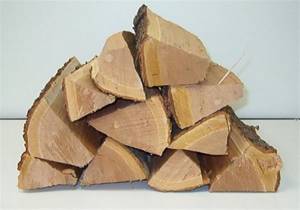
Oak firewood
Pine and spruce firewood have a heat transfer even lower than that of birch and oak. For the heating season, they are purchased 20-30% more. The presence of resin in the logs not only causes a strong crackling sound, they also shoot and can throw pieces of ash onto the floor; if it is wooden, a fire may occur. Therefore, when using this type of firewood, it is recommended to place a metal sheet in front of the stove.
Aspen and alder firewood are highly valued because in addition to providing heat, they clean the chimney of soot, which is why they are rightfully considered “royal” firewood.
Euro firewood performed well when firing a Russian stove, with a complete combustion process and low ash yield. Their price remains high, equal to the cost of coal, but their calorific value is approximately the same.
Step-by-step instruction
Sooner or later, each of us faces the problem of wet firewood, and the situations can be very different. For example, when you need to light a fire in nature to keep warm, cook fish soup, shish kebab, baked potatoes, or when you need to heat the house, prepare a bathhouse to steam and wash.
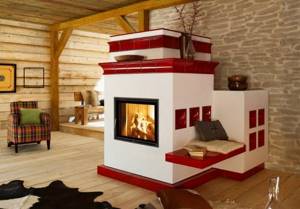
To implement a simple plan for lighting firewood, we will need:
- a good ax, a sharp knife;
- wet firewood;
- fine salt;
- a stack of ordinary newspapers;
- lighter or matches.
First of all, we need to chop some of the firewood into small pieces, chips. Small pieces of wood will quickly dry out and catch fire, while large logs, on the contrary, will negatively affect our fire. A good ax and a sharp knife will allow you to do the work quickly.
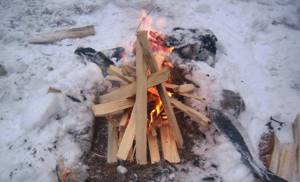
Winter version of a small fire
Note that the firewood inside may well be dry, so we make chips and splinters from the middle part of the logs. If we are dealing with birch firewood, then we remove the birch bark from the blanks. On logs, birch bark will not immediately dry out and catch fire, but separately, on the contrary, it will easily ignite and give the necessary fire.
We build the hut on a pedestal of newspapers, additionally covering the chips on all sides with newspapers. When placing newspapers inside, you should crumple them and give them some volume. If there is birch bark, also lay it deep in the hut. Sprinkle fine salt on top of the structure. Being a good adsorbent, salt will draw out some of the moisture from the wood chips.

Carrying out preparatory activities before lighting the fire
The preparatory measures have been completed, it’s time to set fire to our original structure
At the same time, try to pay attention to whether the wet wood-burning hut made of wood chips will catch fire from the newspapers. If you fail to light a fire the first time, repeat the procedure.
In this case, the dried wood chips will flare up better. If the fire catches on, it’s time to put in a couple of larger logs. This should be done so as not to block the access of air to the fire.
When the fire becomes more confident, you can add more wood. Try not to push too much, clutter the flame, or block the air (oxygen) access to the fire. Large logs can only be laid when you already have a sufficient amount of good coals. If you had to heat the stove with raw wood, then monitor the intensity of the fire, do not let it weaken too much, because if there is not enough heat for new raw logs, then everything may simply go out. Starting a fire requires patience, especially when you are dealing with raw fuel.
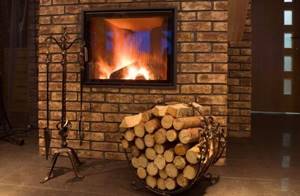
Decorative elements accompanying the stove
In order not to think about whether it is possible to heat the stove with raw wood, do the preparatory work, bring some firewood home and dry it near the stove for the future. Dry firewood stacked near the stove and ready for use will allow you not to think about such problems in the future. In addition, a stack of firewood can make a very original decorative item for the home.
Correct furnace combustion
The operation of the heating structure largely depends on the correct placement of firewood. Most often, three methods are used for laying logs in the flow chamber of the stove:
- horizontal, when firewood is laid in rows one after another with an even distance;
- conical, when pegs are used to form something like a wigwam;
- diagonal, when the first log is placed diagonally, and the rest - at an angle to it.
At the same time, do not fill the firebox to capacity; about 1/5 of it should remain free.
When using coal, ignition is done with wood, and after it burns, a small amount of coal is poured in - a layer of about 5-6 cm. Subsequent fillings can reach a height of up to 15 cm, but the layers must allow air to pass through well. It is recommended to stir the fuel periodically with a poker.
How to light the stove after a long break?
In early spring, when you arrive at your dacha, you will have to light the stove to warm up. But after a long period of inactivity, it is worth lighting a fire in it so as not to damage either the heating structure itself or the residential building.
First of all, check the stove outside and inside for the presence of:
- chips;
- cracks;
- foreign objects;
- small animals and birds;
- soot deposits.
The presence of these inclusions can become a serious obstacle to the normal operation of the device.
Fill cracks and chips with mortar and get rid of foreign objects. To clear the chimney duct of soot accumulation, use a special metal ball on a long rope. The ball can be equipped with a wire brush, then lower it down the chimney and lift it up, repeating these manipulations several times, shaking off the soot after each rise.
Be sure to check for draft if the stove has not been fired for a long time. Light the wood by fully opening all the doors, then close them, adjusting the degree of exhaust. Lay two logs parallel to each other at a short distance, then place the other two on top of them, placing them perpendicular to the first row. Place paper inside and set it on fire.
After a long period of inactivity, do not heat the oven at full power at once. The first combustion should not exceed half an hour; after 4 hours, the kindling can be repeated, increasing the combustion time.
How to properly light a stove
There is a misconception that it is quite simple to melt the village helper - just add the raw materials and the job is done. But even many rural residents do not always know how to correctly and effectively melt and maintain long-term combustion, not understanding why raw logs cannot be used and how to properly prepare the firebox for use.
How to properly stack firewood
Before adding fuel, the system should be prepared for startup. A modern stove device consists of three components: a combustion chamber into which fuel is loaded, a soot and smoke removal system, an ash pan, and a compartment for the accumulation of wood combustion waste.
Before ignition, it is necessary to clean the ash pan, which will ensure free access of air and, accordingly, will significantly simplify the ignition process. After this, you can bookmark it according to the step-by-step instructions:
- open the blower and smoke exhaust channels, ensuring oxygen access;
- open the mine damper;
- cover the bottom of the stove with paper, on which lay an array of firewood (at least a third of the volume of the combustion chamber);
- Now you can set fire to the paper.
Important! It is not recommended to use wood chips during kindling; they generate a lot of heat, and a sudden temperature change can lead to cracking of the chamber. Also, you cannot use various means for kindling (often used by summer residents and tourists to quickly start a fire) - this can lead to damage to the masonry or fire.
There are several known ways to lay beams:
There are several known ways to lay beams:
- The logs are arranged horizontally in a row. The laying should not be too tight;
- cone laying;
- The first log is laid diagonally, the rest at an angle relative to the first.
How to burn wood economically
To effectively use stove heating, you should follow a few simple rules:
- use suitable fuel. For example, for a given stove with water heating it is necessary to burn 0.75 m3 of oak or 1 m3 of birch, 1.2 m3 of alder and pine or 1.5 m3 of aspen firewood;
- control the air flow into the firebox, ensuring the necessary balance between temperature and combustion duration.
How to heat a Russian stove in winter to keep it warm
If a wood-burning device is the only source of heating, heating it will take more than one day. As a rule, it takes several days and constant monitoring of the process in the combustion chamber to bring it into operating mode. It must be maintained with fuel daily when there is no severe frost, and twice a day when severe frost sets in. This will allow the stove device to effectively store and evenly release the accumulated heat, creating a comfortable climate throughout the house.
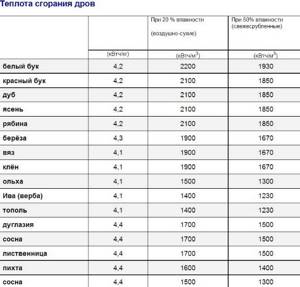
Table: What kind of wood is better to heat the stove in the house
If you are interested in the question of how to properly heat a stove with coal and which is better, read our article.
Ignition of the furnace
For combustion to occur, oxygen must be provided to the firebox. Its regulation is ensured through the blower and the view, which must be open at the beginning of the kindling. When the wood is hot enough, the ash pit is left ajar. The view is completely closed when the blue flame disappears: this indicates that there is no carbon monoxide hazardous to health.
In classic stoves, three components of ignition are important: the space of the firebox itself, the ash pan and the chimney. It is necessary to clean the ash pan and the firebox so that nothing interferes with the free access of air to the fuel.
Before lighting the stove, the firewood must be prepared in advance, calculating the volume needed for the entire burning period. The most important thing is the quality of the firewood. The primary load should be 3⁄4 of the possible load weight. The further combustion process depends on how correctly the first load is calculated.
You will also need flammable materials: birch bark, splinters, paper. To prevent the combustion process from being interrupted, you should put logs along with thin splinters during the first kindling.
The operation of the chimney and blower is invisible. However, these devices should not be ignored, as they contribute to the final efficiency of the entire system. The required amount of air must be supplied to the oven. It is also necessary to completely remove flue gases, including carbon dioxide and carbon monoxide.
You can determine how efficiently the system works by the brightness of the flame. If it is white, the channel is open too wide, and in this case the valve must be closed. A bright yellow flame indicates that everything is normal, access to a sufficient amount of oxygen is ensured.
Which firewood is better?
Heating a stove to heat a home or bathhouse with wood is the most economically efficient way. However, different types of wood produce different efficiency indicators. The duration of burning of logs depends on the density of the tree, therefore, the denser its structure, the longer the logs will burn and the more thermal energy they will release into the room
This is important to consider when choosing firewood
Of course, oak is an ideal fuel in terms of efficiency, but this type of wood is very expensive and heating a stove with oak wood is an unforgivable luxury. That's why
In the middle zone and northern regions of the Russian Federation, it is most acceptable to use birch. Wood of this type optimally combines price and quality. In the southern regions, it is better to use white acacia to fire stoves.
At the same time, in order to heat buildings as efficiently as possible, you need to carefully prepare for the heating process.
When preparing firewood, use trees growing in dry places; they contain less moisture, therefore, they will burn with greater heat transfer. If there are no dry stands, then the fallen logs must be thoroughly dried. The best period of time for harvesting wood for fuel is November-December.
You should not leave cut trees for a long time; if possible, cut them into several parts. The logs that are intended for heating the stove should be of medium size - 8-10 cm in diameter, the length depends on the dimensions of the combustion chamber.
How do you dry firewood? To heat the stove with dry wood.
Wet and damp are better than raw, of course. But dry wood is exactly the type of firewood that needs to be used to heat the stove... Otherwise, it is difficult to achieve the effect that anyone who has experience living with a stove that heats well is used to.
Firstly, you need to protect the firewood, which seems to have dried out from direct precipitation. This will still reduce the possible moisture content of the firewood in inclement weather. When firewood is stacked in several layers, moisture flowing inside the stacks can remain there for a long time. It will increase the moisture content of the wood long after the rain.
Ideally, this is a special firewood shed covered with good roofing material, or at least a firewood shed tightly put together with boards.
Secondly, in order for wet firewood to effectively evaporate moisture, it is necessary to cut it... otherwise it will take a long time to dry.
Thirdly: in order for the firewood to dry completely, it must lie for two seasons, protected from precipitation - in the wind. Therefore, ideally, in a household with stove heating, there should be a supply of firewood for 2-3 years in advance - so that the firewood has time to dry thoroughly.
Caring for a Russian stove
The combustion chamber, an essential part of any unit, is a compartment designed for solid fuel. An ash pit is installed under the firebox, which provides the oxygen necessary to maintain the combustion process, and in addition, ash from burnt wood accumulates in it.
The pipe allows the smoke to be vented out into the atmosphere. It should be properly insulated, as it heats up to a high temperature.
Also, at the very bottom of the Russian stove there is a podpechek or podpechek - a special compartment for storing a supply of firewood. The undercoat was often used for dishes. The six is intended for ease of cooking.
It is important to know not only how to heat a Russian stove, but also how to properly care for it. All furnace passages and working chambers should be cleaned in a timely manner.
The ash compartment is cleaned of accumulated ash every time the firebox is completed. First, its remains in the hearth are swept into the ash pit to be completely removed, for which they use a shuffle - a special metal scoop attached to a long handle.
Typically, major cleaning is carried out once a year on the eve of the heating season. When carrying out cleaning, openings are used that are closed by doors that are provided in the design. This procedure is performed with a poker. It is used to remove the remaining ash and soot accumulated on the inner surfaces of the walls through open holes.
You can remove plaque more thoroughly with a broom made of hard rods. After cleaning, the doors of the openings are tightly closed. The chimney is cleaned of soot, condensation or foreign objects once a year with a special hose or rope with a weight at the end. But in this case it is better to use the help of specialists.
Temperature in the stove when burning wood
Our country has an abundance of forests in its vast expanses; it is for this reason that firewood was, is and will be our most popular type of fuel. By burning chopped logs you can get a large amount of heat. But it’s worth considering: the stove can be heated as efficiently as possible only after reaching certain temperature readings.
The flame temperature has a direct relationship with the type of wood used to work:
- For example, poplar gives a maximum temperature of only 500 degrees. This makes it not very suitable for kindling in winter, as well as in rooms with a large area.
- An excellent solution would be to use oak logs in your work - their thermal indices are 900 degrees.
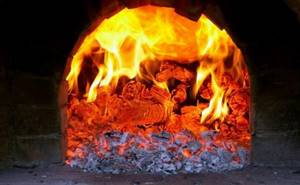
Temperature depends on the type of firewood
Safety regulations
Before igniting the stove, you must immediately calculate the number of expected bookmarks and prepare a supply of firewood
Regular firing of a brick oven is rarely limited to just one fill, which is usually only enough for 6-8 hours of continuous burning. Therefore, most experienced stokers stock up on an additional portion of firewood before lighting the stove. After the first load burns out, they do not wait for “blue lights” to appear on the coals and begin to reload solid fuel into the work area.
Before lighting the stove, it is important to immediately calculate the number of expected bookmarks and prepare an appropriate supply of firewood. The next time you load them, you will need to follow the rules to preserve the accumulated heat and eliminate the possibility of carbon monoxide entering the living space
To quickly ignite new portions, the remnants of the previous stack, along with smoldering coals, are raked in the central part.
Safety rules when lighting the stove
Safe techniques for igniting a stove will allow the user to avoid unpleasant consequences, the most harmless of which is burning through the floorboards in the house
Particular attention is paid to safety issues in buildings associated with high temperatures. These include baths, where ideal conditions for accidental fire are created
Before you start heating the stove with wood in flammable rooms (including the dressing room), it is important to understand the following safety requirements:
- the entrance near the stove must be covered with a metal sheet measuring at least 50x70 mm, which is recommended to be painted with a high-quality fire retardant;
- the distance from the combustion chamber door to the nearest unprotected objects and walls should be maintained at least 1.25 meters;
- It is not allowed to store flammable materials and combustible substances near a home or sauna firebox;
- solid fuel is stored in a separate room or in areas designated for these purposes;
- the furnace is completed at least two hours before going to bed or leaving the room completely;
- It is prohibited to operate the stoves if there is the slightest suspicion of their malfunction.
It is prohibited to use kerosene and other flammable liquids for ignition.
During combustion it is strictly prohibited:
- use kerosene, diesel fuel, gasoline, as well as other flammable and combustible liquids for ignition;
- store a supply of firewood in a heated room that exceeds the daily requirement;
- leaving a burning stove unattended;
- dry and store firewood and other flammable materials on it;
- to burn furnace structures unsuitable for their use with coal or coke;
- use logs of firewood whose length is significantly greater than the size of the firebox, and also operate the stove with the doors completely open.
We invite you to familiarize yourself with Installing a firebox in a sauna
Safety measures or basic rules for stoker
Any source of fire carries a hidden threat. If fire safety rules are not followed, the lives of loved ones are at serious risk. Therefore, it is worth following simple recommendations.
- Light a Russian stove only using birch bark or paper. Do not use gasoline, kerosene, or other flammable chemical compounds for kindling.
- Do not burn household waste, polymer waste, or glossy magazines.
- Always close the damper tightly to prevent sparks or burning embers from creating a fire hazard.
- It is strictly forbidden to heat the stove with sawdust and other small wood debris. Sawdust evenly covers the fireplace and prevents air from entering, causing the flame to go out. An explosion is possible if there is a sudden supply of oxygen.
- Make sure that flammable substances and objects do not touch the walls of the oven.
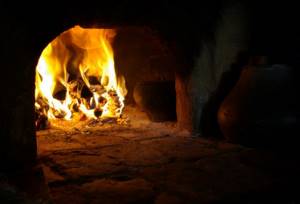
How to heat it correctly?
In order for the firewood to burn quickly, stack it correctly. The best methods are considered to be parallel laying or a well. These provide good ventilation of the firewood with fresh air and excellent draft during the combustion process. There is no need to stack firewood in a hut. The high temperature will be concentrated near the roof of the furnace, and cracking of the walls is possible.

When the Russian stove is hot enough near the mouth, you can place cast iron pots with the dishes being prepared. The soup and the main course will simmer without direct fire. And baking sheets with shangs, pies, and baked goods are sent into the oven.
But when the coals burn out, you can put them with a poker in the near part of the stove, and when they are covered with ash and stop flaring up with tongues of flame, close the damper on the chimney about halfway. Only when the blue flames completely disappear can the view be closed completely.
“Secret” placement of logs: crumple the paper, lay it down, and lay dry splinters and pieces of birch bark on top like a hut. Now it's time for the firewood. We lay out a two-tier well from thin logs. We make sure that there are gaps for air access. This way the kindling is in the center. We light a long piece of birch bark and bring it to the paper.
What temperature should it be?
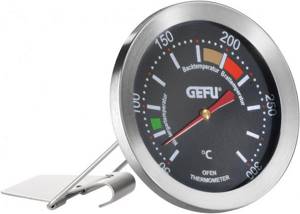
It is better to use a special thermometer for ovens
To ensure that the stove serves for a long time and does not crack, it is better to use a special fire-resistant thermometer. And maintain the temperature in the hearth no higher than 700 ̊ C. It is preferable to heat more often, but with less intensity. To determine readiness for baking, you can use a piece of paper. What is the temperature in a Russian oven and how to determine it visually? Place the piece inside and watch the charring process:
- turned black immediately - the temperature in a Russian oven is above 300°C;
- after 30 seconds – heat in the range of 230-250°C;
- after 1 minute – 200°C;
- after 5 minutes – 180°C;
- not charred at all - less than 150°C.
How to heat a stove with wood - instructions and useful tips.
First, prepare dry firewood...
